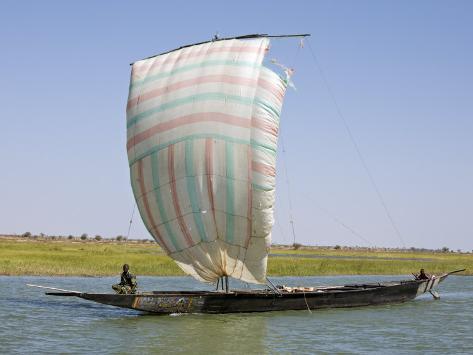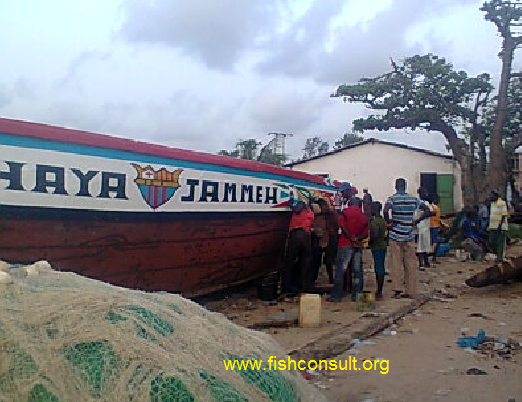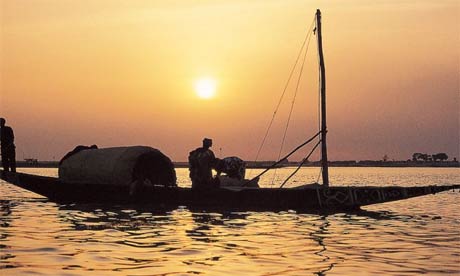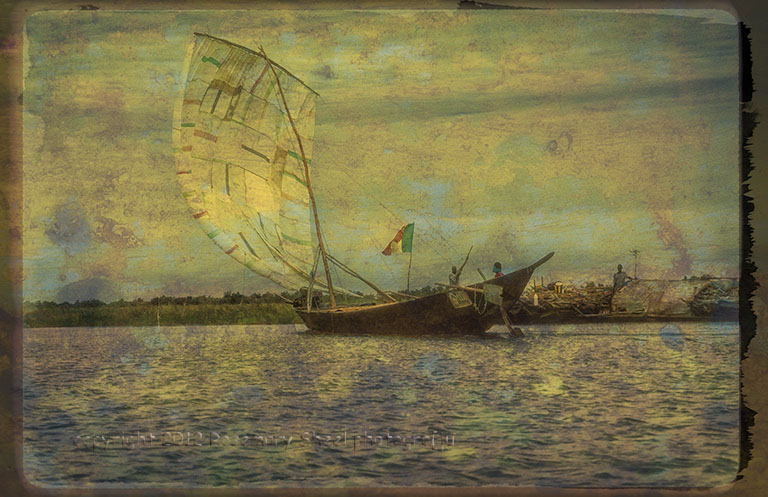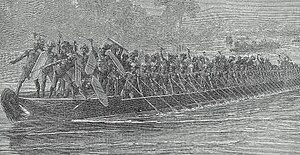| Traditional African Boat Designs by kingston277(m): 6:51pm On Jul 02, 2014 |
I usually don't make topics on forums but people have covered other interesting African cultural topics here and I thought indigenous water vessels, rarely discussed at all for some reason, should be touched on more as well. It might also help provide incite into the Malian voyage to the Americas theory. I'm going to try to post up some of the larger, more ship-like ones while I'm at it. Niger river    From wiki: It is known by historians that at its height the Mali Empire built a large naval fleet under Emperor Mansa Musa in the late 13th and early 14th century.[23] Arabic sources describe what some consider to be visits to the New World by a Mali fleet in 1311.[24] http://en.wikipedia.org/wiki/ShipWiki on Cape Verde: Possible visits from Africa
The Portuguese explorers discovered the islands in 1456 and described the islands as uninhabited. However, given the prevailing winds and ocean currents in the region, the islands may well have been visited by Moors or Wolof, Serer, or perhaps Lebou fishermen from the Guinea (region) coast. http://en.wikipedia.org/wiki/History_of_Cape_Verde#Possible_visits_from_Africa |
| Re: Traditional African Boat Designs by kingston277(m): 8:03pm On Jul 02, 2014 |
|
| Re: Traditional African Boat Designs by kingston277(m): 8:06pm On Jul 02, 2014 |
1 Like |
| Re: Traditional African Boat Designs by kingston277(m): 8:07pm On Jul 02, 2014 |
Pharaoh Khufu's Ship Width: 19.5ft Length: 143ft |
| Re: Traditional African Boat Designs by kingston277(m): 8:07pm On Jul 02, 2014 |
Kongo |
| Re: Traditional African Boat Designs by kingston277(m): 8:09pm On Jul 02, 2014 |
|
| Re: Traditional African Boat Designs by kingston277(m): 8:12pm On Jul 02, 2014 |
The following info provided by user Physics and co.  Pleep: African Man building a fishing sailboat in the same way his ancestors did hundreds of years ago.
http://polishingpeanuts.com/wp-content/uploads/2011/01/Will-Boase-African-Boat-Builder.jpg
There are also many first hand accounts of malian ships from the 1400's
The ships from mali were " full size" so to speak, with sails and decks. Around the size of columbus's ship the Pinta, which i have had the pleasure to see, which measures i would guess around 50 feet? |
| Re: Traditional African Boat Designs by kingston277(m): 8:15pm On Jul 02, 2014 |
PhysicsMHD:
Really?
1:

http://kennethgarrett.photoshelter.com/gallery-image/Nubian-Pharaohs/G0000zfJA49PwJoY/I0000Y9NTS0w.xmE/P0000F0AYdFLNvYI
2 :

3:

http://kennethgarrett.photoshelter.com/gallery-image/Nubian-Pharaohs/G0000zfJA49PwJoY/I0000eFrLPwfZhKg/P0000F0AYdFLNvYI
4:
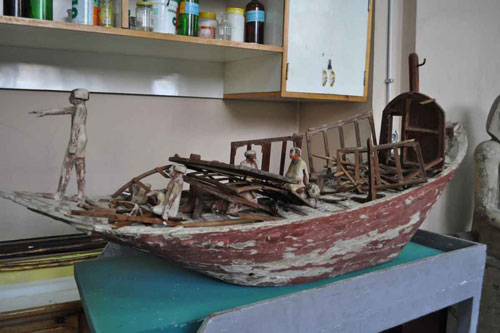
http://www.artsjournal.com/culturegrrl/2011/02/one-armed_tut_hawass_issues_de.html
5: http://en.wikipedia.org/wiki/Nubia_%28Mesolithic%29_/_Nile_boat
"A very important question arises about hull construction. Only two options are known to be available: a hull formed from a large log (tree trunk) or built up as with a papyrus reed boat. True planked hull construction cannot be documented earlier than the 1st Dynasty with the discoveries at Tarkhan of planked hull boards that were re-used as coffin and roof timbers [6] However the architectural features of the Khartoum Mesolithic boat were refined and executed, they received broad acceptance among Egyptian ship builders and were widely utilized in nautical architecture during the next periods of Egyptian history. The limited opportunities provided by the Papyrus reed raft had been transcended.[7] Mankind's ability to utilize the resource opportunities provided by the broad Upper Nile basin, and the large Nile delta of Upper Egypt had taken a quantum leap forward with this 'new' boat design as depicted on the Khartoum Mesolithic pebble."
6: http://antiquity.ac.uk/ProjGall/usai/index.html
"In particular the image of a steering gear fixed to a vertical pole inserted in the stern upper hull can be found in boat rock engravings from the Abka region in Sudanese Nubia; and from Akkad which is south of the third Cataract on the left bank of the Nile in the Northern Dongola Reach. The blade strongly resembled those of the boat of El Khab. This kind of composite helm was still in use on Egyptian ships built during the New Kingdom. The dome-like cabin on the upper hull is also a well known feature on boat representations dating to the Gerzean and Predynastic periods in Egypt and Nubia."
^^^^^
Educate yourself man. Nubian boat making was quite ancient and influential.
Also,
7:

"These drawings show the carved decoration on two stone vessels found in rich graves at Qustul, in northern Nubia, dating to about 3400-3200 BCE. These vessels, carved of Nubian stone, show kings sitting in boats and wearing the "White Crown". This crown was once associated only with Egyptian kings. Because these vessels came from Nubia, some archaeologists think these kings may not be Egyptian but very early Nubian rulers. Also shown in these carvings are: a palace front, bound prisoners (suggesting that these scenes commemorate a victory), and a lion in a boat (perhaps symbolizing the king)."
http://www.dignubia.org/maps/timeline/bce-3400.htm
8:
In particular, note that:
http://nautarch.tamu.edu/Theses/abstracts/vinson.html
http://nautarch.tamu.edu/Theses/pdf-files/Vinson-MA1987.pdf
^^^^
So the earliest evidence of boats in that area (around the Nile) has been found in Nubia, it influenced Egyptian boat building, and there is reason to believe certain aspects of Egyptian boat building influenced that of the Greeks. |
| Re: Traditional African Boat Designs by kingston277(m): 8:16pm On Jul 02, 2014 |
PhysicsMHD: 9:
http://en.wikipedia.org/wiki/African_military_systems_%281800%E2%80%931900%29
"In the Niger Delta, the bigger Itsekiri war canoes mounted multiple cannon and swivels, and carried 40 rowers and 100 warriors, with slaves doing most of the rowing duties. Slaves were also tasked with providing food for the canoe men.[8] Commerce sometimes operated closely with war-making. Itsekiri traders operated their own fleets of fighting vessels, and the British navy was often unable to stop these fast-moving warrior-merchants as they flitted between the streams, lagoons and waterways of the Delta. On several occasions they fended off British warships by blockading narrow creeks and waterways, and in disputes with the colonial regime or European merchants, shut down trade on the Benin river for several months.[9] Pirates also made use of fast canoes to plague commerce and local citizenry alike. War-canoe ports were often fortified with extensive stockades, and multiple trench lines, behind which teams of gunmen and other fighters were marshalled for defense.[10]"
[8] ^ P. C. Lloyd, "The Itsekiri in the Nineteenth Century; An Outline Social History," The Journal of African History, Vol. 4, No. 2 (1963), pp. 207-231
[9] ^ Lloyd, op. cit
[10] ^ Robert Smith, The Canoe in West African History, The Journal of African History, Vol. 11, No. 4 (1970), pp. 515-533.; Lloyd, op. cit
10:

"Iboe war canoe"
R and J. Lander, Journal of an Expedition to Explore the Course and Termination of the Niger, (London 1832). pp. 283-214"
"Ibo war canoe from Nigeria, circa 1830s, demonstrates a blend of indigenous and imported technology. Construction is of a single log. Steering is provided by two oars-men in bow and stern. Muskets stand ready on the fighting platform in the center, and captured enemy flags and trophies fly overhead. Swivel guns and small cannon were sometimes installed."
http://en.wikipedia.org/wiki/African_military_systems_%281800%E2%80%931900%29
" 'Fo'castles' had also been noted by Pacheco on the
(presumably sea-going) canoes of the Ivory Coast,20 and the feature occurs
in the canoes seen in the Niger Delta by the Landers; one of the drawings
in the latter's account of their journey in I830 shows an 'Iboe canoe' with
about twenty-two men engaged in paddling, two standing in the bows
and stern with long poles as steersmen, and a platform amidships on
which three warriors are standing and a number of muskets are stacked.21"
- Robert Smith, The Canoe in West African History, The Journal of African History, Vol. 11, No. 4 (1970), pp. 515-533
(note 'fo'casles' above is an old spelling of forecastles (the upper deck of a ship))
11:

A Duala war canoe, Cameroon, 1884. Scan from Middlemen of the Cameroons Rivers: The Duala and Their Hinterland, c. 1600–c. 1960 by Ralph A. Austen and Jonathan Derrick. Originally from an illustration in Die Gartenlaube: Illustriertes Familienblatt, vol. XXXII, no. 37. Based on an original photograph. |
| Re: Traditional African Boat Designs by kingston277(m): 8:17pm On Jul 02, 2014 |
|
| Re: Traditional African Boat Designs by kingston277(m): 8:17pm On Jul 02, 2014 |
PhysicsHD: 13.
"Two possible lines of explanation suggest themselves for this distinction
between seafarers and the rest. The first is geographical. On the Gold
Coast, firm beaches, backed by relatively open and dry country, afforded
easy access from the land to the sea, while the small promontories which
jut out south-westwards from Axim nearly to Accra gave shelter from
the prevailing wind and current to the beaches in their eastern lee.14
East of the Volta, moreover, lagoon systems roughly parallel to the coast,
and networks of rivers offered alternative and less hazardous water
communication and fishing. A second explanation may be sought in the
early history and traditional origins of the different peoples. The Yoruba,
for example, who have few references to the sea in their myth and legend,
seem in origin to have been an inland people who settled near the coast
only within the last four or five hundred years; though they made much
use of canoes on their lagoons and rivers, it is unlikely that in precolonial
times they ever ventured through the Atlantic surf on to the open sea.15
The West African canoes, each 'carved' and 'dug out' from the trunk
of a tree, [b]varied considerably in size, from small fishing canoes carrying
a crew of from one upwards, to canoes over 8o ft. in length and with a
complement of one hundred men or even more. The largest canoes were
built for the relatively calm waters of the lagoons and great rivers.
Fernandes, writing about I506, speaks of 'huge canoes carrying I20
warriors' on the Sierra Leone river, while Hawkins saw boats on the
Sherbro which were some 24 ft. long, carved and painted, and could
carry some sixty people in calm water.'6 Pacheco writes of large canoes
in the same area which carried up to fifty men and were used for war
and other purposes. But he was especially impressed by the canoes on
the Rio Real (the Bonny and New Calabar rivers in the eastern delta of
the Niger): 'The bigger canoes here, made from a single trunk, are the
largest in the Ethiopias of Guinea; some of them are large enough to
hold eighty men '.7 According to Dapper, these canoes of the Rio Real
had their own cooking hearths, and special arrangements for the storage
of the crew's sleeping mats."' Barbot adds that they were much larger
than the canoes on the Gold Coast, 'some being 70 ft. in length, and
7 or 8 ft. broad; very sharp pointed at each end, fitted with benches
athwart for the conveniency of the rowers, who sit as near the sides of
the canoes as is possible'. Some had 'a sort of quarter-deck, made of
strong reeds'.19 'Fo'castles' had also been noted by Pacheco on the
(presumably sea-going) canoes of the Ivory Coast,20 and the feature occurs
in the canoes seen in the Niger Delta by the Landers; one of the drawings
in the latter's account of their journey in I830 shows an 'Iboe canoe' with
about twenty-two men engaged in paddling, two standing in the bows
and stern with long poles as steersmen, and a platform amidships on
which three warriors are standing and a number of muskets are stacked.21
The war canoes with which Kosoko, the exiled Oba of Lagos, attacked
across the lagoon towards his former capital in I853, were apparently
of two types, some being 8o ft. in length and carrying 'upwards of a
hundred men', while others carried thirty to forty men each.22 [/b]On the
Upper Niger, where there were few large trees, tree trunks were occasionally
joined by cords end-to-end (rather than as a catamaran).23
The usual method of propulsion for the canoes was by paddles and, in
shallow lagoon and river-water, by punting. Barbot refers to the use of
sails by the natives of Axim and Winneba, and implies their use also off
the Senegal coast.24 The sails on these sea-going canoes were presumably
of cloth, perhaps copied from the Portuguese, and their rig probably
afforded a limited capacity for sailing into the wind. The canoes seen by
members of the I84I Niger expedition at Fernando Po, however, were
fitted with sails of grass fibre attached to masts of light cane.25 The Yoruba
on their lagoons, according to G. J. A. Ojo, used 'woven fresh palm
branches held upright and turned as the occasion demanded', but John
Whitford noted that the trade canoes plying between Badagry and Lagos
in i865 were fitted with square sails 'of strong cotton cloth, woven in the
interior, blue, white or striped '.26 On the Upper Niger, sails were apparently
unknown and the wind was by no means a friend to sailors.
Nevertheless, transport could be quite rapid, though Es-Sadi's claim to
have navigated 300 miles in 5 days on the Niger (presumably with the
current) is perhaps exaggerated.27" |
| Re: Traditional African Boat Designs by kingston277(m): 8:18pm On Jul 02, 2014 |
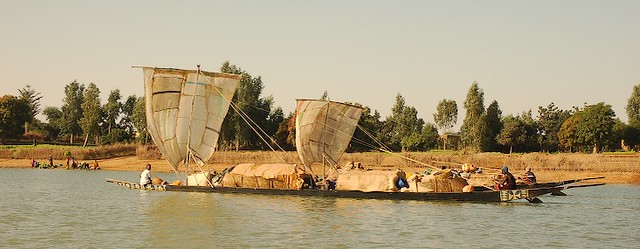 PhysicsRND: "West African canoes were constructed according to a method which
probably varied little for over a thousand years, and in places is still
practised (though it is doubtful whether any of the largest types have
been built in recent years). Olfert Dapper described the manufacture
of canoes on the Gold Coast in this passage:
They are made all in one piece, from a single tree trunk, which the Negros
fashion in this way. They round off the trunk at each end, then dig it out
with an iron tool. They leave the thickness of two fingers at the bottom and
one finger on the sides: and then burn straw in the hollow, in order to prevent
the sun from splitting the boat or worms from entering. The sides are propped
up by wooden posts [presumably to prevent expansion of the wood on heating]
, Some of the largest size are made at Cabo das tres Puntas, where trees
grow which are seventeen or eighteen spans in circumference.28
Most of the West African canoes in use today are pointed at both
bow and stern, but another common hull-form ends in dovetail projections,29
which on lagoon and river canoes are sometimes wide enough to form
a platform for poling. Thwarts are often absent, and there is no evidence
of the use of outriggers or, until the present century, of leeboards. Accounts
of contemporary canoe-building30 indicate that the softer woods are
preferred as material, Ceiba pentandra (the silk cotton tree) and Triplochiton
scleroxylon being in special demand for bigger craft. After felling and
shaping, the trunk is excavated by an adze-like iron tool. In the case of
large and heavy boats built in the bush, the operation is sometimes
carried out by cutting sections which the builders then excavate simultaneously,
leaving temporary bulkheads between each section in order
to facilitate the draining of rainwater. Excavation is usually completed
by burning out the interior, using dry grass as fuel. This operation serves
to disinfect and preserve the fabric of the boat (since a tar-like substance
is produced by the heating of the wood) and to drive out insects and other
parasites. During the burning, the wood tends to expand; in the case
of the sea-going canoes this-and the resultant cracking-is prevented
by squeezing the canoe between props; lagoon and river craft, on the
other hand, are allowed to expand, and then contraction on cooling is
prevented by placing struts of wood across the boat. Paddles are made
of wood, carved according to various patterns, and poles from bamboo or
palm. The finished canoe is taken to the nearest navigable water either
by motor transport or by the ancient method of rolling it over a pathway
of logs. The life of a lagoon canoe is reckoned at only some 2-3 years, but
the more costly and carefully made canoes for sea fishing, when properly
treated and 'patched', are used for up to 15 years.31"
|
| Re: Traditional African Boat Designs by kingston277(m): 8:19pm On Jul 02, 2014 |
PhysicsRND: "[b]In pre-colonial times, as now, the builders were specialists, often (in
the case of those building the bigger boats) living in the forests which
provided the raw material, where they either were visited by their clients
or worked from 'childrens' boats' sent to them as models. According to
Barbot, 'Axim, Ackum, Boutroe, Tacorary, Commendo, Cormentim and
Wineba' were 'the most noted places' on the Gold Coast for canoes,
which were sold by the builders there both to their neighbours and to
the Europeans; the men of 'Achombene' were also reputed as builders
and suppliers of the larger canoes.[/b]32 On the Upper Niger, two servile
peoples, the Tyindiketa and the Zendji, were prominent in the Songhay
empire both as boat-builders and as crews,33 and from the sixteenth
century may have been making larger vessels from planks (presumably
carvel, not clinker-built) as well as canoes.34 In the Niger Delta, where the
ubiquitous mangrove was unsuitable for boat-building, canoes were
supplied by the Ijo from the forested region of the upper Benin river,
though the Apoi of the central delta were also known as builders and
hirers of canoes.35 In Lagos, the smaller canoes were built on the beaches,
while the larger ones were obtained from the inland forests.36 A noted
boat-building centre in the Ijebu kingdom in the early nineteenth century
was 'Boughiye', said by Osifekunde, the informant of the French ethnographer
D'Avezac, to lie on the south shore of the Lagos lagoon and
to be 'famous throughout the country for the superiority of the vessels
that come from its boatyards '.3 As this is a sandy region with few trees
other than palms, wood was presumably imported here from the mainland.
II
For hundreds of years the canoe, both as a ferry and as a means of lateral
communication, has played a major role in the political and economic
life of West Africa. It has been said that 'mountains divide, rivers unite',
and the history of the Niger bears out the latter part of this statement."
- The Canoe in West African History
Author(s): Robert Smith
Source: The Journal of African History, Vol. 11, No. 4 (1970), pp. 515-533 |
| Re: Traditional African Boat Designs by kingston277(m): 8:21pm On Jul 02, 2014 |
[img] http://3.bp..com/-0dOr6aFg_MU/UEjpEvbXtGI/AAAAAAAABfw/NdGzw0FzQME/s640/8kyocanoe8tj.gif[/img] PhysicsMHD: In Dafuna Canoe, History is Being Made
ARCHAEOLOGY: by Kazeem Adeleke
--------------------------------------------------------------------------------
The dream is great and when fully accomplished, will be one of the greatest historical documentations and tourist attractions in the whole of Africa. "What we are trying to do is to build a museum where the canoe will be kept. There, a lot of people from across the world will come and see it. I must tell you, this will be a major tourist attraction in the whole of Africa," says Dr. Omotoso Eluyemi, Director and Chief Executive of the National Commission for Museums and Monuments last week.
Since the Dufuna canoe was discovered by a local Fulani herdsman in 1987 archaeologists have been in a frenzy about the discovery.
The canoe which was excavated by a combined team of Nigeria and German archeologists in 1994 at Dufuna, a village along the Komodugu Gana river in Fune local government area of Yobe State has continued to amaze them for the simple reason that it has changed the course of history.
Presently undergoing conservation at Damaturu, Yobe State, it was dug out from a depth of five meters beneath the earth's surface and measured 8.4 meters in length, 0.5 meters wide and about 5 cm thick varying at certain parts of the surface. The age of the canoe has been put at about 8000 years old (6000 BC), thus, becoming the oldest boat in Africa and third oldest on earth.
The canoe belongs to the Late Stone Age period (Neolithic Age), when humans ceased to roam the face of the earth hunting to become herdsmen and cultivators and in the process becoming modifier of their environment with complex social structures in response to new problems and ways of dealing with situations.
"The discovery of this boat is an important landmark in the history of Nigeria in particular and Africa in general" says Eluyemi.
Besides proving that the Nigerian society was at par (if not earlier) than that of Egypt, Mesopotamia, Minoa and Phoenicia, the discovery also provides the first concrete evidence that Africans possessed the ability to reason and have been exploring technology to modify their environment to suit their needs.
But more importantly "the canoe has shown that people in the Niger area had a history of advanced technology and that they had mastered the three major items of Paleolithic culture which were the fashioning, standardization and utilization of tools according to certain set traditions," explains Eluyemi.
But beyond that, the discovery has also revealed that, Nigerians were not static people. "It gives concrete evidence of transportation by seas as well as providing evidence of some form of long distance commercial activities indicative of existing political and economic structures."
One great benefit of the discovery is that it has helped archaeologists draw a relationship between what was happening in Nigeria and else where in the world during that period. Indications are that while Nigerians were making canoes in Dufuna village in 6000 BC, the people of Catol Huyuk in Turkey were making pottery, textiles etc, like the people of Mesopotamia (present day Iraq) were forming urban communities and the Chinese were making painted pottery in the Yang Shao region. But particularly of interest to archaeologists is the proof that some form of advanced civilization existed in the Lake Chad Basin around 6000 BC.
Documentation has showed that based on the minimal available technology during this period, the making of the Dufuna canoe must have been a ponderous task which called for mastery, specialization and ingenuity. A lot of work, man hours and skill must also have been put into the production since no iron tools were in existence at the time. The tools used were probably Post Pleistocene ungrounded core axe - like and pick - axe bifacial tools of microlithic appearance. It can be assumed that the canoe must have been made near a river to eliminate the difficulty of transporting it over long distances.
Read more: http://egyptsearchreloaded.proboards.com/index.cgi?board=hist&action=display&thread=591#ixzz1J5UDSfQN
|
| Re: Traditional African Boat Designs by kingston277(m): 8:22pm On Jul 02, 2014 |
|
| Re: Traditional African Boat Designs by kingston277(m): 8:25pm On Jul 02, 2014 |
Mtepe: an indigenous Bantu invention[img] http://4.bp..com/-wf9AdKhLKps/UEpdOWfSaEI/AAAAAAAAHAE/21l4tJF7P_8/s1600/800px-House_of_wonders_inside_zanzibar.jpg[/img] The mtepe is a sewn ship. It is associated with the Swahili people (the word "boat" in the Bantu Swahili language being mtepe). The mtepe's planks are held together by wooden pegs and coconut fibers. [img] http://kandilivilla.files./2011/11/house-of-wonders11mtepe.jpg[/img] The Mtepes of Kenya
Among the indigenous boats that disappeared in the 20th century was the mtepe, the world's last large sewn vessel. The last mtepe built was in 1930, and the last one in existence was wrecked in 1935 (they might have been the same vessel: my sources are unclear).
History and Usage
Unique to the Swahili culture of east Africa, mtepes were built in the Lamu archipelago off Kenya. Evidently an old design, their origin is unknown: there are references to sewn boats in the region that date back to classical antiquity and to the earliest years of Portuguese exploration, but these might have been other designs that were similar to mtepes in some respects. The earliest unmistakable references to mtepes date from the 19th century.
Mtepes were of two types, the mtepe proper, and the dau la mtepe, which superseded it. The transition apparently occurred in the 19th century because, while there are contemporary models and documentary evidence of the earlier mtepe, the only photos seem to be of the later dau la mtepe. Both were double-ended and generally similar in design, but there were a few significant differences between the types, which we'll get to below. (I will use "mtepe" in Roman text to refer to both types, and will italicize it as mtepe to refer to the mtepe proper as distinct from the dau al mtepe.) |
| Re: Traditional African Boat Designs by kingston277(m): 8:26pm On Jul 02, 2014 |
Mtepes varied considerably in size. Most seem to have been between 40 and 75 feet (I presume that the measurements were taken on deck, and did not include prow extensions, bowsprits or outboard rudders) and of 12 to 50 tons burthen, but one recorded in the 19th century was 30 meters long and 186 tons. All references report them to have been very fast and able sailors, easily able to out-point settee-rigged dhows. This is surprising considering their rig, which consisted of a single square sail of palm leaf matting.
Faza in the Lamu archipelago was the center for mtepe building: as many as 20 were being built there annually early in the 20th century. With a crew of about 20, they traded north to Zanzibar and south to Kenya's Mrima coast. Toward the end of their employment, their primary cargo was mangrove poles, but earlier cargoes included grain, pottery, cattle, salt, firewood and slaves. To collect the mangrove cargoes, the crew would punt the vessel into a swamp and cut and load the poles themselves, receiving payment from the proceeds of the voyage on a "share" basis. Oars were also used for propulsion when necessary.
Mtepes leaked copiously, so bailing was constant. It is recorded that, as a test for employment, a prospective crew member had to demonstrate his ability to lift a bailer full of water measuring 24" in diameter and 9" deep. (This works out to about 3 U.S. gallons or 25 pounds. As a test of strength, lifting it isn't impressive, especially when considering that the bailer was made of woven palm leafs and probably leaked, and that it was very wide and shallow, so unlikely to have been lifted full in any case. On the other hand, if you're bailing a vessel, lifting that weight several hundred times per hour is indeed an impressive demonstration.) |
| Re: Traditional African Boat Designs by kingston277(m): 8:27pm On Jul 02, 2014 |
With their deep V-shaped hulls and flexible sewn construction, mtepes were not stiff enough to lie on their sides. They were never allowed to take the ground unless supported by props.
Construction
The mtepe bears many similarities to dhows and the two might have influenced each other's development in unknown ways in ancient times. Certainly, the dau al mtepe (which I think translates roughly as "dhow-style mtepe" ) adopted some of the characteristics of the dhow late in the 19th century.
A crew of five or six carpenters, being supervised by the ship's future captain, would typically built a mtepe in two to three months, including harvesting their own timber, which was used green. Like all relatives of traditionally-built dhows, mtepes were built shell-first, on a keel, with smooth-laid planks of mangrove wood. (I hesitate to call it carvel, because that implies a construction method and certain details which do not apply here.)
Garboards were sewn or stitched to a one-piece keel. It is not known whether the keel was rabbeted. On many dhows, the garboard butts against the side of the keel or a beveled surface at the intersection of the top and sides. Stem and sternpost were lashed to the keel only after two or three strakes were in place. There were no deadwoods or stem knees. Partial-length planks were scarfed diagonally without butt blocks.
Planking the hull was an enormously laborious process. After holes were drilled through the planks near both edges, the planks were sewn together with three-strand coir (coconut husk cord). First, coir fiber was pounded into the seam from inside. Then, over the seam was spread a thick paste of made of pounded mangrove bark, the tannin in which preserved the coir caulking. Onto the paste were laid strips of crushed coconut husk, and then a layer of palm leafs. A sharpened piece of palm leaf was attached to one end of the cord and used as a sewing needle. Men worked in pairs, inside and outside the hole.
Each time the man inside passed the cord through the hole, he would pound it with a mallet to compress the package of caulking material beneath the stitch, then would plug the hole with a tapered plug to hold the cord in place temporarily, until his turn came for the next stitch. The man outside would wrap the cord around a short stick, place one end of it against the hull, and lean back, using the stick as a lever to tighten the cord before passing it back through the next hole. About six feet of seam length was sewn at a time, the coir being passed around and through each hole several times, both straight up and down and diagonally. Tapered plugs were then pounded into each hole from the outside.
After the the hull was completely stitched, the plugs outside the hull were cut off flush, and then the stitches themselves were cut off on the outside! This would leave the planks fastened to each other by thousands of very short pieces of cord, held in place only by the plugs pounded in from outside – a very odd way to address the vulnerability of the stitches outside the hull. This last process was omitted only near the stem and sternpost, and apparently some mtepes were built with the stitches remaining on the outside over their whole surface. |
| Re: Traditional African Boat Designs by kingston277(m): 8:28pm On Jul 02, 2014 |
Most reports indicate that after the strakes were sewn together, pegs were inserted by drilling obliquely upward into the outboard face of a plank so that the drill exited the plank on the edge and penetrated the plank above it also on its edge. Others disagree, claiming that the strakes were first edge-drilled on their matching faces, "dowel tenons" set into the holes, and the upper strake then pounded down onto the lower one. Only then were the planks through-drilled and sewn together.
If the first method (oblique pegging) is correct, then the pegs' main function seems to be to eliminate shear between adjacent strakes. If the second method (edge-set pegs) is correct, then the pegs seem to function primarily as an assembly aid. In both cases, the stitches are primarily responsible for holding the planks tight against each other. It is not impossible that both methods were used.
Interior framing was added only after strakes were in place. Amidships, there were futtock frames which rested on floor timbers but were not attached to them. Moving outboard were half-frames, and then one-piece frames (i.e., gunwale to gunwale) in the very ends. The frames were lashed to the hull with a few light cords passed through holes in the planks. Frame spacing was reportedly wide, but no specifics are available. Five or six sets of cross-beams or thwarts were installed in pairs, upper and lower, separated by a few planks. These were notched and passed through the planks, and were gammoned to each other. In addition to transverse strength, the upper thwart of each set served as deck supports and mast partners. Two or three stringers were installed, so lightly lashed to the frames that they seem to have provided little lateral strength: perhaps they helped support and secure the cargo.
During the southwest monsoon, when the mtepe was laid up annually, every stringer and frame was removed and every stitch was replaced. With a full crew working, the job could be done in about eight days.
Rig
Although most reports indicate a plum mast, more recent measurements of models and photographs indicate that the mast had a forward rake of 6 to 14 degrees. The mast was supported by a forestay, two backstays, and usually one shroud per side, although some mtepes may have had a single shroud that was passed from one side to the other when tacking – a rare occurrence for tradewind sailors. |
| Re: Traditional African Boat Designs by kingston277(m): 8:29pm On Jul 02, 2014 |
The sail was made from many strips of plaited palm leaves, sewn together. There were two or three sets of reef points near the head of the sail. The sail was supported by a yard and a boom of delicate appearance. The yard was equipped with parrels; the boom with a simple loop of rope to perform that function. In addition to a halyard, the yard was supported by two "lift braces," which served both functions implied by that name. As I don't understand how this could work, I'll copy my source and perhaps a reader can explain:
"(The yard) is hoisted to the mast-head by means of a halyard supplemented by two lateral tackles which combine the functions of lifts and braces and may therefore be termed "lift braces". The upper end of the halyard is rove through a sheave-hole some way below the mast-head and made fast to the middle of the yard. Each lift-brace functions through a purchase fitted between the mast-head and one end of the yard, a tackle consisting of two single blocks. One end of the rope is rove through the block at the end of the yard, passes to the block at the mast and returns to be made fast to the yard-arm just inner to the first block. These lift-braces, as the name implies, also control the set of the yard; by slacking away on one and hauling on the other, the yard is veered." ("The Sea-Going Mtepe and Dau of the Lamu Archipelago," James Hornell, Mariner's Mirror, January 1941)
Differences Between Mtepes and Dau al Mtepes
Throughout the above discussion, I've treated both types of vessels together, as the features described seem mainly to have applied to both. But there were some differences between mtepes proper and dau al mtepes, some obvious and others significant but not apparent.
The stem and stern of a dau al mtepe were raked considerably more than those of a mtepe, so that, for boats of identical length, the dau would have a far shorter keel. The stem of the mtepe was surmounted by a large curved terminal that may have represented a camel's head. The dau had no such device, but instead had a long bowsprit. The mtepe was more colorful and far more highly decorated, with occuli both fore and aft, painted bands on the topmost strakes, and amulets, tassels and flags. Perhaps by the time the dau came into being, the trade was already under competitive pressure from other, more modern boat types, and decoration was discarded as uneconomic. |
| Re: Traditional African Boat Designs by kingston277(m): 8:29pm On Jul 02, 2014 |
The most interesting difference, however, was in the construction of the stem and sternpost. The mtepe had fairly conventional timber posts, except that the stem was in two pieces joined by an unusual mortise-and-tenon joint open at the front and rear. The dau al mtepe's was even stranger: it consisted of a series of stacked, V-shaped breasthooks, each one about as tall as a strake, tapering aft, and pegged to one another. In some cases, a solid timber was fastened outboard of this stacked construction. It is not known how planks were fastened to the stems/sternposts in either case, or if the timbers were rabbeted.
In 2003, a mtepe was built for an exhibit on dhow culture at the House of Wonders Museum in Zanzibar. The design was to be a roughly half-size (but not half-scale) interpretation of a mtepe that had been measured in 1877 at 97 feet long, 24 feet beam, and depth of 9.5 feet (apparently including draft plus freeboard). The boatbuilder who was contracted for its construction it had never worked on a mtepe, but had heard about some of the construction processes from his grandfather, who was one of the last builders of dau al mtepes. Even though guided by academics and museum personnel, the builder diverged from several known aspects of mtepe construction, most notably in building the boat frame-first as opposed to shell-first, and in refusing to cut off the plank lashings on the hull's outer surface. Named Shungwaya, the boat was briefly tested in Zanzibar harbor, where it proved to be quick and to leak somewhat as expected. It is now on display at the House of Wonders Museum. http://indigenousboats..ca/2012/09/the-mtepes-of-kenya.html |
| Re: Traditional African Boat Designs by kingston277(m): 10:03pm On Jul 02, 2014 |
. |
| Re: Traditional African Boat Designs by kingston277(m): 4:20am On Jul 08, 2014 |
|
| Re: Traditional African Boat Designs by kingston277(m): 7:14pm On Jul 10, 2014 |
|
| Re: Traditional African Boat Designs by kingston277(m): 9:05pm On Jul 21, 2014 |
Somalia 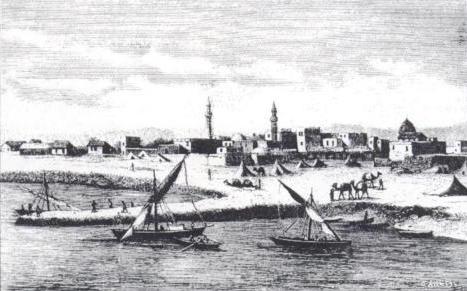 |
| Re: Traditional African Boat Designs by cedarville: 1:45pm On May 10, 2015 |
hi,
you seem very knowledgable in traditional african craft and i was wondering if you knew people still building wooden boat and who would be willling to have an apprentice or somebody Learning and working with them. I was timber framer and got my diploma in France 2 years ago, i spend a year working as a bench maker in South africa and just spend this year building boats in united states. But i'm interested in traditional crafts and would like to build asian or african traditional boats rather than western still.
if you have any information or contact i'll be glad to talk with you and exchange about boat building |










